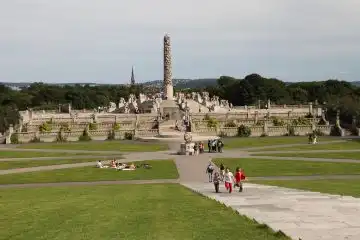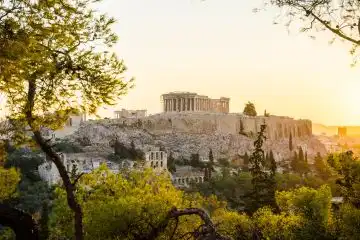A trip to explore Vatican city and rich history in Rome Italy
Exploring the rich history in Rome Italy is like stepping into a living museum where every stone, alley, and monument tells a story. As the heart of the Roman Empire and the cradle of Western civilization, Rome is an unparalleled destination. That firstly attracts the history enthusiasts and art lovers. Within this captivating city lies Vatican City-the world's smallest independent state. That is packed with some of the most awe-inspiring religious and artistic masterpieces.
This guide takes you on a memorable trip through the wonders of Rome and Vatican City. The famous landmarks of Paris are as scenic as of Italy. It further unveils the best sites that showcase centuries of influence, power, faith, and creativity.
1. The Timeless Charm of the Colosseum
The Colosseum, also known as the Flavian Amphitheatre, is an enduring symbol of Rome's imperial power. Built in 70-80 AD, this is an iconic structure. That had once hosted gladiatorial contests, animal hunts, and public spectacles for up to 80000 spectators.
Today, the Colosseum stands as a testament to ancient Roman engineering and architecture. A guided tour will enrich your experience of exploring rich history in Rome Italy during the visit. It further comes with stories of Roman emperors, legendary battles, and the societal importance of entertainment. That had played a main role in shaping the rich history in Rome Italy.
Tip: Book an underground tour for access to the hypogeum. Further, it is a network of tunnels and cages beneath the arena floor.
2. Vatican Museums - A Treasure Trove of Art
The Vatican Museums are a labyrinth of galleries brimming with priceless artworks and religious relics. From classical sculptures to Renaissance masterpieces, the collection further spans thousands of years of human creativity.
Highlights include the stunning Raphael Rooms, the intricate Gallery of Maps, and the vast collection of Roman antiquities. Every corner of the museums showcases the depth of Vatican City's contribution to global art and culture.
Insider Tip: Allocate at least half a day for your visit. That further helps you to truly savor the grandeur and details of these extensive museums.
3. St. Peter's Basilica - A Testament to Spirity
Rising majestically from St. Peter's Square, Saint Peter's Basilica is one of the most revered sites in Christendom. Completed in the 17th century, it stands further as a marvel of Renaissance architecture.
Inside, marvel at Michelangelo's Pietà, Bernini's ornate Baldachin, and the cavernous domed ceiling. For breathtaking city views, climb to the top of the dome. It is a panoramic reward that further spans the rooftops of Rome and Vatican City.
The basilica encapsulates the rich history in Rome Italy making it worth to explore. It further blends religious significance with architectural brilliance.
4. Exploring the Roman Forum - The Beating Ancient Rome
Nestled between the Palatine and Capitoline Hills, the Roman Forum. It was once the bustling epicenter of Roman political, commercial, and social life.
Stroll past the Temple of Saturn, the Arch of Titus, and the Curia. Meanwhile, imagine the debates, trials, and ceremonies that unfolded here. The Forum is a vivid reminder of Rome's imperial legacy and the foundation of Western governance and law.
Don't miss the nearby Palatine Hill, believed to be the birthplace of Rome. It firstly offering sweeping views of the Forum and Colosseum.
5. Sistine Chapel - Michelangelo's Celestial Masterpiece
The Sistine Chapel is located within the Vatican Museums. It is firstly a world-renowned masterpiece of religious art. Michelangelo's ceiling frescoes, particularly "The Creation of Adam," captivate visitors with their detail, emotion, and scale.
The chapel firstly serves both as a sacred space and the venue for the Papal Conclave. Its spiritual significance combined with artistic brilliance makes it one of the most unmissable sites in Vatican City.
Tip: Visit early or late during the day to avoid peak crowds and immerse yourself in the art.
6. Castel Sant'Angelo - Rome's Fortress
Originally constructed as Emperor Hadrian's mausoleum, Castel Sant'Angelo. It has morphed into a fortress, papal refuge, and museum over the centuries.
Connected to the Vatican by the Passetto di Borgo-a secret passage used by popes in times of danger. This fortress firstly offers a unique perspective on Rome's turbulent history. Meanwhile, climb to the top for panoramic views of the Tiber River and St. Peter's Basilica.
Its fascinating layers further make it an essential stop when exploring the rich history in Rome Italy.
7. Vatican Gardens - A Hidden Oasis of Serenity
However, few visitors know about the Vatican Gardens. They are a beautifully maintained expanse of manicured lawns, fountains, and sculptures spanning nearly half of Vatican City.
Accessible only via guided tours, these gardens provide an intimate glimpse into the private world of the popes. The tranquility here contrasts beautifully with the bustling museums and basilicas. That meanwhile offer a moment of reflection amid Renaissance beauty.
8. The Pantheon - Rome's Best-Preserved Ancient Wonder
Standing since 125 AD, the Pantheon is a breathtaking example of Roman engineering. It firstly contains massive domed ceiling and oculus. That is still the world's largest unreinforced concrete dome and continue to astonish architects and visitors alike.
Originally built as a pagan temple, it was later converted into a Christian church. It had been preserved through centuries. Inside, you'll find the tombs of famous Italians for example Raphael, adding to its cultural significance.
The Pantheon embodies the essence of the rich history in Rome Italy making it worth to visit. There, ancient ingenuity meanwhile meets timeless beauty.
9. Piazza Navona - Rome's Baroque Masterpiece
Built on the site of an ancient Roman stadium, Piazza Navona is a lively square. It is firstly known for its elegant Baroque fountains, street artists, and cafes.
Bernini's Fountain of the Four Rivers is the centerpiece, depicting the world's major rivers in stunning detail. Surrounding palaces and churches meanwhile reflect Rome's rich artistic heritage.
Further, it's the perfect spot to relax and sip espresso. Here, you can watch the world go by while soaking up centuries of art and history.
10. Trastevere - Rome's Charming Bohemian Quarter
Meanwhile, cross the Tiber River and explore Trastevere, one of Rome's oldest and most vibrant neighborhoods. With its cobblestone alleys, medieval churches, and ivy-covered buildings, Trastevere feels like a step back in time.
Home to the Basilica of Santa Maria, trendy cafes, and family-run trattorias, Trastevere is the ideal place. Here, you can meanwhile experience rich history in Rome Italy and it's daily life. The district beautifully fuses history, culture, and local traditions.
Wandering through Trastevere reveals the intimate layers of the rich history in Rome Italy. That firstly lies far away from the grand monuments.
11. Vatican Necropolis - Rome's Hidden Underground History
Beneath the grandeur of St. Peter's Basilica lies the Vatican Necropolis. It is an ancient burial ground further dating back to the first century.
Known as the Scavi, this archaeological site houses early Christian tombs. It is believed to contain the final resting place of Saint Peter. Access is limited and requires advance booking, but it's a profoundly moving experience. That further connects you directly to the roots of Christianity.
12. The Spanish Steps - A Cultural Crossroads in Rome
The Spanish Steps are a sweeping staircase of 135 steps. They connect Piazza di Spagna with the Trinità dei Monti church above. Built in the 18th century, this landmark is both an architectural gem and a social hub.
Surrounded by boutiques, cafes, and art galleries, the steps are a perfect spot to take a break. You can meanwhile do people-watch, and admire the urban landscape.
They embody the blend of culture, history, and everyday life. That further defines Rome's timeless appeal.
13. Campo de' Fiori - History and Modern Life
Campo de' Fiori, once the site of public executions, is now one of Rome's most beloved squares. By day, it's a bustling open-air market further offering fresh produce, flowers, and local delicacies.
By night, it transforms into a lively gathering spot with restaurants and wine bars. At its center stands a statue of philosopher Giordano Bruno, commemorating the square's historical significance.
This vibrant plaza firstly captures the spirit of Rome-ever-evolving yet deeply connected to its past.
14. Capitoline Hill and Museums - The Cradle of Rome
It is the smallest but most important of Rome's seven hills. Capitoline Hill firstly offers both ancient significance and stunning views. Designed by Michelangelo, the piazza and surrounding museums house some of Rome's greatest treasures.
Admire the bronze statue of Marcus Aurelius, ancient sculptures, and paintings. That meanwhile tell the story of Rome's rise and influence. The museums provide deeper insight into the rich history in Rome Italy and its enduring impact. That further falls on the modern world.
Conclusion - For Rome and Vatican City
A journey to Rome and Vatican City is a deeply rewarding experience. That firstly offers a blend of art, history, and culture like nowhere else. It takes you from exploring ancient ruins and Renaissance masterpieces to uncovering hidden gems like the Vatican Necropolis. Above all, every corner of this region tells a story.
The rich history in Rome Italy is not only found in its monuments but also in lives. That are found on in its vibrant streets, local traditions, and timeless beauty. Here, you can marvel at the Sistine Chapel's ceiling or savor pasta in a Trastevere trattoria. Rome further offers moments that stay with you long after your visit ends.







